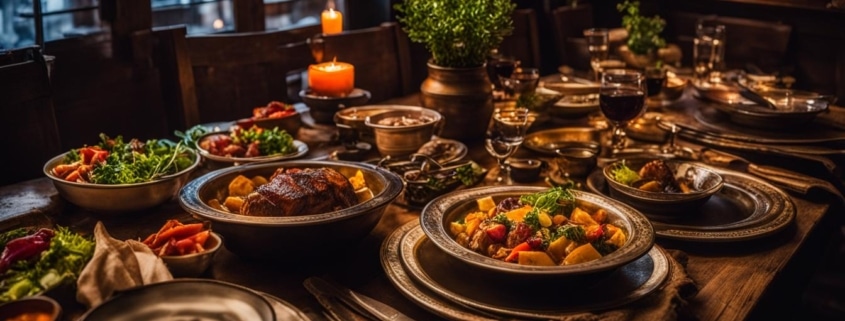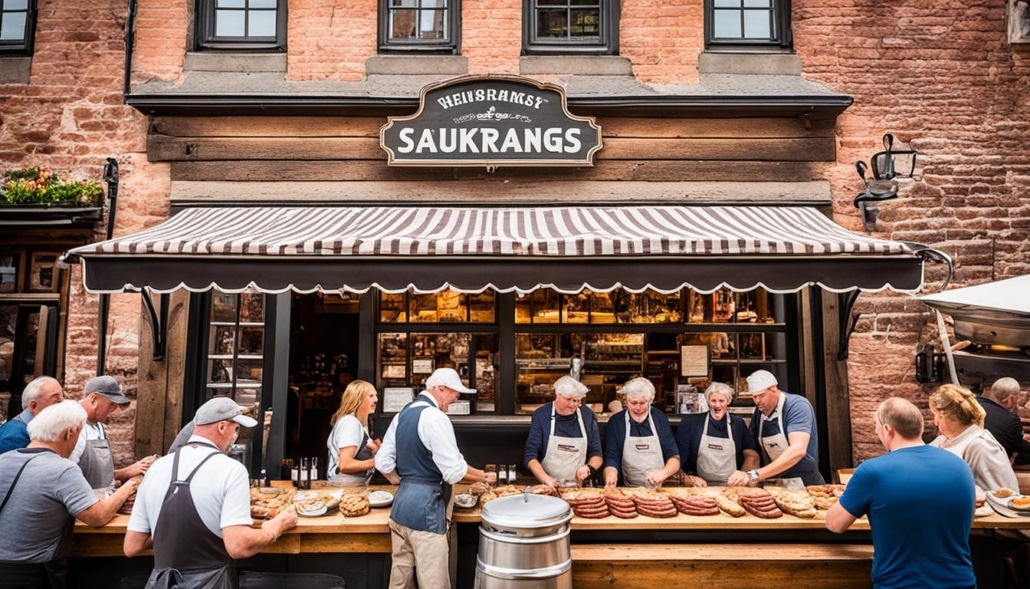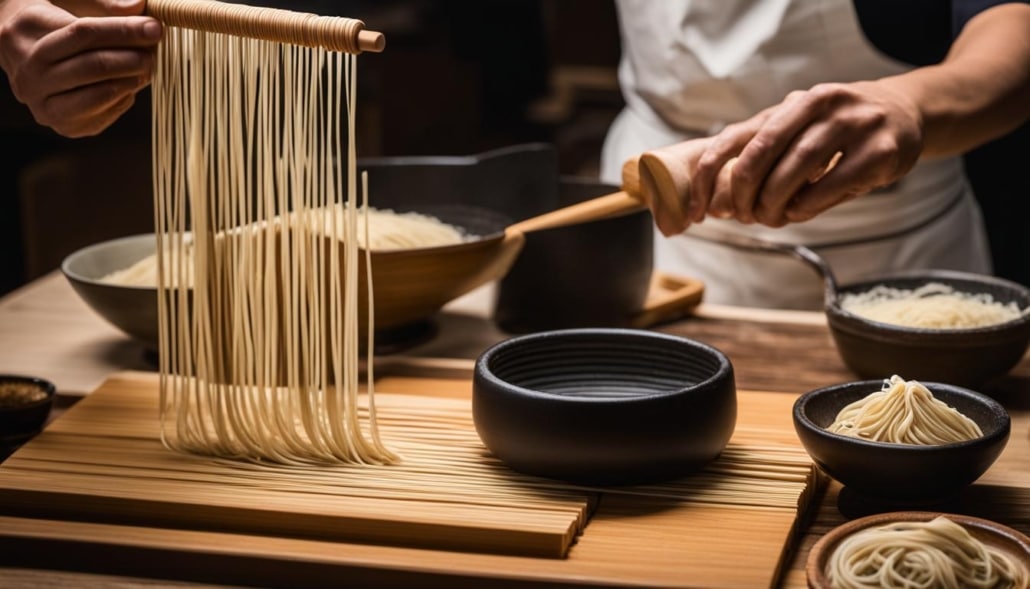Historic Eateries: Dining in the World’s Oldest Restaurants
Restaurants that have stood the test of time are a testament to their resilience and enduring appeal. Let’s explore some of the world’s oldest restaurants that have been serving patrons for centuries, preserving culinary history and offering traditional dining experiences. These historic establishments have not only provided delicious meals but also acted as cultural touchstones, passing down recipes and chronicling history.
Key Takeaways:
- Food tourism allows us to embrace the past and experience traditional dining.
- Historic restaurants offer a glimpse into culinary history and cultural heritage.
- These establishments have been serving patrons for centuries, preserving recipes and traditions.
- Visiting these restaurants is an opportunity to appreciate the rich tapestry of flavors that have stood the test of time.
- Exploring the world’s oldest restaurants is a culinary journey through time.
St. Peter Stiftskulinarium: Europe’s Oldest Restaurant
Nestled within the walls of the historic St. Peter’s Abbey, the St. Peter Stiftskulinarium in Salzburg, Austria, stands as a testament to centuries of traditional dining. Dating back to 803 AD, this renowned establishment holds the distinguished title of being Europe’s oldest restaurant. Over the course of its remarkable 1,200-year history, it has welcomed illustrious patrons, including Christopher Columbus and Wolfgang Amadeus Mozart.
Stepping into St. Peter Stiftskulinarium is akin to journeying back in time. Visitors have the opportunity to savor the same dishes that have been enjoyed for generations, meticulously prepared with the utmost respect for tradition. The restaurant features 11 elegant dining rooms, each adorned with charming period decor, creating an ambiance that perfectly complements the culinary experience.
“At St. Peter Stiftskulinarium, history and gastronomy converge to offer a truly unforgettable dining experience. This venerable establishment serves as a living testament to the rich culinary heritage of Austria. The combination of exquisite flavors, impeccable service, and the grandeur of the Benedictine monastery creates an atmosphere that captivates the senses and transports guests to a bygone era.”
Guests can indulge in a range of authentic Austrian dishes, with one signature offering deserving special mention: the world-famous wiener schnitzel. Savored for its tender veal coated in crispy breadcrumbs, this classic dish remains a highlight of the St. Peter Stiftskulinarium’s menu. Accompanied by a selection of fine wines sourced from the local vineyards, each meal at this distinguished establishment is a celebration of culinary history.
The Rich History of St. Peter Stiftskulinarium
The origins of St. Peter Stiftskulinarium can be traced back to the Benedictine monastery founded by Saint Rupert in the 7th century. The restaurant, established later in 803 AD, was primarily intended to serve the monks and important guests of the monastery. Over the centuries, it grew in popularity and became a cherished culinary destination for locals and visitors alike.
The historic importance of St. Peter Stiftskulinarium extends beyond its gastronomic delights. It has acted as a cultural hub, hosting numerous influential figures throughout history. Whether it was hosting Mozart’s wedding reception or providing sustenance to weary travelers during the tumultuous times of the Napoleonic Wars, this venerable establishment has always been at the heart of Salzburg’s vibrant cultural tapestry.
St. Peter Stiftskulinarium continues to honor and uphold its legacy, welcoming guests from around the world to experience the magic of traditional Austrian cuisine at the oldest restaurant in Europe.
| Highlights of St. Peter Stiftskulinarium | Reasons to Visit |
|---|---|
| 1 | Immerse yourself in 1,200 years of history |
| 2 | Indulge in traditional Austrian cuisine |
| 3 | Experience the ambiance of 11 ornate dining rooms |
| 4 | Savor the world-famous wiener schnitzel |
| 5 | Discover the cultural significance of the Benedictine monastery |
Wurstkuchl: A Taste of History in Germany
Step into the Middle Ages with a visit to Wurstkuchl, a German tavern that has been in operation since the late 12th century. Situated near the Danube River in Regensburg, this historic restaurant started as a small stand selling boiled meat. Over the centuries, it has transitioned into a beloved establishment renowned for its house-made pork sausages grilled over charcoal. Accompanied by sauerkraut and mustard, these sausages continue to delight both locals and visitors.
The Journey from Broth Stand to Culinary Icon
Wurstkuchl’s origins can be traced back to the Middle Ages when it served as a simple broth stand for locals and travelers passing through Regensburg. The popularity of its hearty boiled meat attracted a steady stream of customers, prompting its evolution into a full-fledged tavern.
As the demand for sausages grew, Wurstkuchl became renowned for its traditional preparation methods and high-quality ingredients. The restaurant’s sausages, made from locally sourced pork, are seasoned with a unique blend of spices and then grilled over an open charcoal fire. This cooking technique imparts a smoky flavor and a tantalizing char to the sausages, enhancing their taste and appeal.
A Culinary Tradition that Endures
Despite the passage of centuries, Wurstkuchl has remained steadfast in its commitment to preserving the flavors and techniques of the past. The sausages served at the tavern today closely resemble those enjoyed by diners in the Middle Ages, allowing patrons to savor a taste of history.
Accompanied by classic German sides such as sauerkraut and tangy mustard, Wurstkuchl’s sausages offer a delectable combination of flavors. The sauerkraut, made by fermenting finely shredded cabbage, provides a sour and crunchy contrast to the savory sausages. Meanwhile, the mustard adds a tangy kick, elevating the overall taste experience.
“Wurstkuchl’s sausages offer a delectable combination of flavors.”
A Historic Setting
Aside from its culinary delights, Wurstkuchl’s location in Regensburg adds to its charm. The city itself is steeped in history and is known for its well-preserved medieval architecture. Visitors to Wurstkuchl can enjoy their sausages while taking in the picturesque views of the Danube River and the iconic Stone Bridge.
Experience the Legacy
A visit to Wurstkuchl is a gastronomic journey back in time, allowing diners to immerse themselves in the culinary traditions of the Middle Ages. The combination of historical ambiance, perfectly grilled sausages, and traditional accompaniments creates an unforgettable dining experience.
| Highlights of Wurstkuchl |
|---|
| Famous for its house-made pork sausages |
| Over 800 years of history |
| Located near the Danube River in Regensburg |
| Offers breathtaking views of the city and river |
Honke Owariya: Ancient Soba Tradition in Japan
In the heart of Kyoto, Japan, lies Honke Owariya, one of the oldest restaurants in the country. Established in 1465 as a confectionery shop, this family-run establishment has been serving its signature soba noodles for over five centuries. The restaurant’s soba mochi, created by the 13th generation, is a must-try dish. Guests can savor the delicate flavors of cold soba accompanied by various toppings, all prepared with fresh Kyoto spring water.
The History of Honke Owariya
Honke Owariya’s story dates back to the Muromachi period, a time of cultural and artistic flourishing in Japan. Originally renowned for its confectioneries, the restaurant’s founders, the Rikyu family, later transformed their establishment into a soba noodle shop to cater to Kyoto’s growing appetite for this traditional dish.
Preserving Tradition and Craftsmanship
What sets Honke Owariya apart is its unwavering commitment to traditional soba-making techniques. The restaurant not only uses quality buckwheat flour but also grinds it in-house to maintain the integrity of flavors. The dough is carefully kneaded, rolled, and cut into thin soba noodles, honoring centuries-old practices that have made Honke Owariya a culinary institution.
A Culinary Delight for the Senses
When visiting Honke Owariya, guests not only indulge in the flavors of their signature soba dishes but also immerse themselves in the restaurant’s unique atmosphere. The traditional architecture, tranquil setting, and attentive service provide a truly authentic dining experience.
“Honke Owariya is not just a restaurant; it’s a portal to the past. With each bite of their soba noodles, you can taste the history and tradition that has been passed down through generations.” – Food critic, Kyoto Times
Conclusion
Embarking on a journey of food tourism allows us to delve into the rich tapestry of culinary history and traditions found in the world’s oldest restaurants. These historic eateries not only offer mouthwatering dishes but also provide a captivating glimpse into the cultural heritage of different regions.
One such restaurant is the renowned St. Peter Stiftskulinarium in Salzburg, Austria, dating back to 803 AD. Here, guests can savor traditional Austrian cuisine and experience dining in a setting that has witnessed the presence of historical figures like Christopher Columbus and Wolfgang Amadeus Mozart.
Traveling to Wurstkuchl, a German tavern established in the late 12th century, allows visitors to indulge in the flavors of the Middle Ages. The house-made pork sausages grilled over charcoal, accompanied by sauerkraut and mustard, continue to delight both locals and tourists.
Finally, Honke Owariya in Kyoto, Japan, stands as a testament to the ancient soba tradition. Having served its signature soba noodles for over five centuries, this family-run establishment offers guests the opportunity to taste the delicate flavors crafted with fresh Kyoto spring water.
By exploring these oldest restaurants, food enthusiasts can truly appreciate the connection between culinary history, traditional dining experiences, and the artistry of flavor that has persisted throughout the centuries.
FAQ
Are these restaurants still in operation?
Yes, all of the mentioned restaurants are still open and serving customers today.
Can I make a reservation at these historic restaurants?
Yes, it is advisable to make a reservation in advance, especially during peak tourist seasons.
Do these restaurants serve traditional cuisine?
Absolutely. These restaurants pride themselves on preserving culinary traditions and offer authentic traditional dishes.
Are these restaurants only popular with tourists?
While these restaurants do attract tourists interested in experiencing their historical significance, they are also frequented by locals who appreciate their traditional dining experiences.
Can I expect a unique ambiance at these historic eateries?
Yes, these restaurants often feature unique and charming interiors that reflect their centuries-old history and provide a memorable dining ambiance.






Leave a Reply
Want to join the discussion?Feel free to contribute!